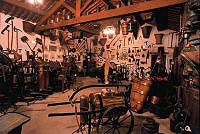The Museum, which is located in Rasteau (5km from Vaison la Romaine), was founded by Paul Coulon in 1982, in an old farmhouse on the estate. To introduce the Museum, who better than Professor Emile Peynaud. Here is an extract from the visitors' book at the Winegrower's Museum: the wonderful dedication with which he graced it.
"INVITATION TO THE WINEGROWER'S MUSEUM"
"The roots of our vines stretch back into the history of time, just as they stretch deep between the stones. Each year, since they were first planted in these parts, the vine-stocks have tirelessly re-emerged from the harsh winter and strict pruning, blossomed one fine day in June, and offered the grower the grapes of Vendémiaire.(1) The grapes then bubble away and produce the new wine, which is renewed yearly, always the same and always varied, and bears the stamp of its vintage! Wine is the living memory of our past. It is all about continuity: a work of art, the work of artisans – and poets, wise men and scholars have always been its patrons. A band of elite labourers have strived to nurture it, busy among the vines with their hoes; with picks, swing-ploughs, bunch-cutters and back-baskets; in the privacy of the vat room with the crusher, the press, and the cooperage tools of yesteryear. This Winegrower's Museum pays tribute to the generations of vine-cultivators, of labourers, of cartmakers, of grapepickers, of cellar workers, of coopers and many more, who, gesture after gesture, season after season, life after life, have made Châteauneuf-du-Pape into the perfect wine it is today. Why? Because any great wine, crafted and tended and burnished by time and human hands, is the logical culmination of a tale of love and work. Friends and visitors to the Winegrower's Museum, let me offer a word of warning before you undergo the trial of the tasting room: above and beyond the immediate waves of pleasure that will wash over you when you taste Domaine de Beaurenard's wines, and once your palate has got over the initial surprise, seek rarer virtues in your glass – virtues concealed there through the ages, and without which these wines would not be what they are. Do this and you will recognise great humanity, patience, perseverance and heart."
Emile PEYNAUD, June 1985
(1) The first month of the French Revolutionary calendar: 22 September to 21 October.
Besides an impressive collection of old tools (the museum has more than 2,500!), displayed in a friendly and welcoming setting, you must visit the "Vinothèque" and its collection of 2,000 bottles, some of the blown-glass exhibits are more than a hundred years old (1880, 1884 and 1929!).

7 exhibition rooms
-
 The visit begins in the Clairette Room, a veritable trove of treasures patiently salvaged from oblivion: old ploughing implements, swing-ploughs, hoes, and so on.
-
The Grenache Room showcases carts, draught-horse harnesses, cellar and cooperage tools, a crusher, a press, magnificent pickers' back-baskets, oak casks, taps, a boiler cum watering device for scalding insects off the vine, a superb collection of vine sprayers, root injectors for fighting phylloxera, and more.
-
The Cinsault Room retraces the development of pruning tools: the serpette, a sharp hooked blade used in the Stone Age; the serpo-sécateur; and most recently the more conventional sécateur, in use since the 1920s.
-
In the Mourvèdre Room you can watch a video about the Châteauneuf du Pape appellation and the Côtes du Rhône vineyards. This 20-minute film offers a fascinating insight into the AOC's production rules, its history, tourism and gastronomy, and tips for pairing food and wine from our prestigious appellation.
-
The Syrah Room features information displays on the area's geology, agronomy, amphelography (the science of grape varieties and vinestocks), oenology, meteorology, economics, gastronomy, the wine-waiter's art, the brotherhoods of wine connoisseurs, the civilisation of wine and the Vinothèque.
 The tour is rounded off with a visit to the tasting room, featuring the AOC's "symphony of 13 varieties" and, of course, the wines made at Domaine de Beaurenard. The tour is rounded off with a visit to the tasting room, featuring the AOC's "symphony of 13 varieties" and, of course, the wines made at Domaine de Beaurenard.
In addition, there's an outside courtyard for adults and children alike to unwind, in the shade of the lime trees and plane trees, sheltered from the Mistral. Here you can rest at your leisure, near the cool spring that runs down from the neighbouring hills where our vines grow...
A museum tour commentary is available on personal stereos.
|







